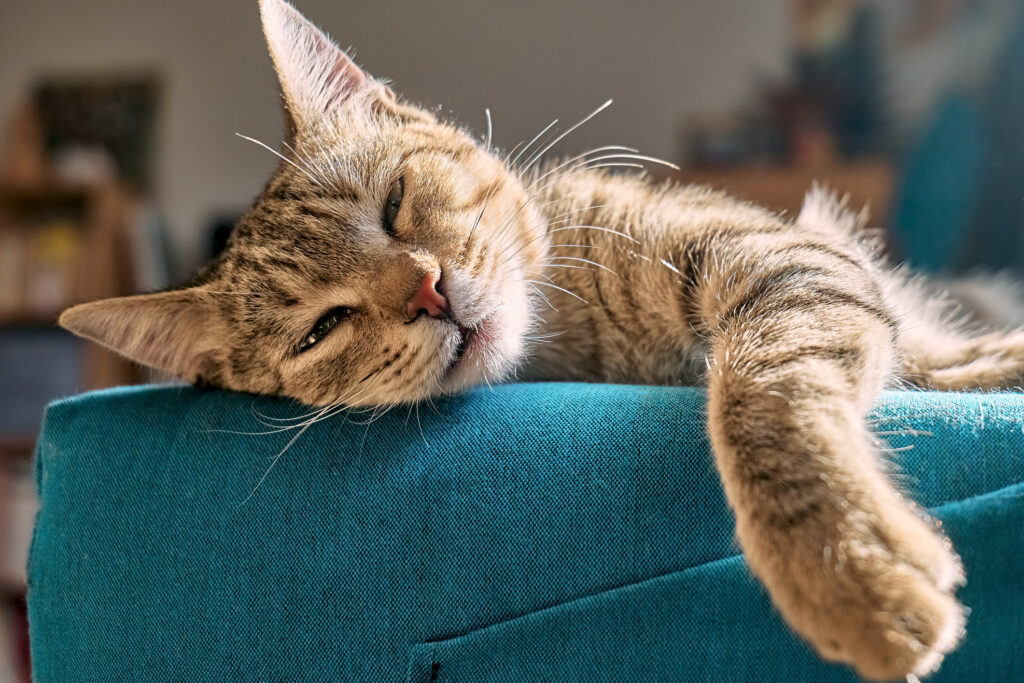What Is Lethargy in Cats? How Is It Treated?

Photo by Ekaterina Fedulyeva/iStock/Getty Images Plus
Cats love a good nap, but there’s a difference between a tired cat and a lethargic cat. If your cat seems unusually inactive or withdrawn, you should contact your veterinarian promptly.
If your cat is weak, unresponsive, or has labored breathing, that signals a medical emergency that requires immediate care at an emergency clinic.
To help you recognize the signs of lethargy in cats and respond quickly, we spoke with veterinarians about common causes and the steps to take if your cat is acting lethargic.
Key Takeaways
- Regular checkups, vaccines, and parasite prevention are some of the best ways to keep your cat healthy and prevent feline lethargy.
- Lethargy is a common warning sign of many illnesses in cats. Knowing what’s normal for your cat makes it easier to recognize when something is off.
- Lethargy can be mild and temporary, but it can also signal a serious or even life-threatening condition. Always contact your veterinarian for guidance on caring for a lethargic cat.
What Is Lethargy in Cats?
Veterinarians define lethargy as weakness or a noticeable decrease in activity and alertness.
It’s not simply slowing down; lethargy describes a cat that is moving less and as if they are drunk or drowsy, explains Maggie Placer, DVM, a veterinarian with EveryCat Health Foundation in Lafayette, Louisiana. It’s their body’s way of conserving energy when something abnormal is going on.
Many pet parents say their cat is “lethargic” when they’re quieter than usual, less interested in play, or spending more time resting, says veterinarian Emma Choi, DVM, based in Mendocino, California. “Sometimes pet parents are describing normal behavior—like an exhausted cat napping more after a long night of activity—rather than true medical lethargy,” she says. Either way, veterinarians stress that it’s best to be proactive and call your vet if you notice a change in your cat’s behavior.
“Paying attention to small changes in appetite, weight, or activity can go a long way toward preventing lethargy from becoming the first noticeable sign of illness,” says Amanda Stevens, DVM, medical director at Veterinary Emergency Group (VEG) ER for Pets in Alpharetta, Georgia.
While any cat can experience lethargy—Dr. Stevens says it’s one of the most common reasons pet parents bring their pets to an emergency clinic—senior cats may be more vulnerable due to age-related illnesses.
What Are the Signs of Lethargy in Cats?
If a cat is simply napping more after a busy night but perks up when meals are served or their favorite toy jingles, they are likely OK. A truly lethargic cat stays withdrawn, often hiding or lying in places they normally do not, even when offered food, treats, toys, or attention.
If your cat is lethargic, they may:
- Act less aware of their surroundings
- Be slow to react
- Lack interest in play or interaction
- Seem weak or have trouble walking or moving around
- Hide or avoid social interaction
- Eat less or not at all
- Have trouble getting to or using the litter box
What Causes Lethargy in Cats?
Lethargy is always a sign that something isn’t quite right with your cat. However, the causes of lethargy can range from mild to serious or even life-threatening.
Common causes of lethargy in cats include:
Mild issues
Moderate to severe issues
- Infection
- Dental pain
- Parasites
- Anemia
- Organ failure
- Diabetes or diabetic ketoacidosis (DKA)
- Hypoglycemia (low blood sugar)
- Heart disease
- Blood clot
- Kidney disease
- Toxicity
- Intestinal blockage
- Trauma or internal injuries
- Pancreatitis
- Cancer
Keep in mind that this list isn’t comprehensive, because there are many possible reasons a cat might become unusually tired or weak.
When To Call Your Vet
Because lethargy is nonspecific and the possible causes are so wide-ranging, veterinarians take every case seriously. Even if your cat is lethargic but eating and drinking, it’s best to call your vet.
If your cat is lethargic and not eating or drinking, is weak or unresponsive, or has labored breathing, take them to the nearest emergency clinic right away.
Whatever the cause for lethargy in your cat, your veterinarian can help figure out what’s going on and recommend how to address the underlying issue.
How Do Veterinarians Diagnose and Treat Lethargy in Cats?
To get to the bottom of what is causing your cat’s lethargy, veterinarians may rely on several exams and tests.
Vital signs
“When a lethargic cat comes into the ER, the first thing we do is check their vital signs—heart rate, breathing, temperature, and gum color—to gauge how sick they are and how urgently they need care,” Dr. Stevens says. Checking their blood pressure is also something to help assess the level of lethargy your cat has.
In serious cases, such as severe pain, breathing difficulties, or shock, a veterinarian may place an intravenous (IV) catheter and start treatments like IV fluids, oxygen, and pain medication right away.
Patient history
Your veterinarian will ask for every detail leading up to when your cat became lethargic, including any other symptoms and even small minor changes that seem unrelated. If it’s a new vet, make sure to let them know any previous medical issues your cat has had in the past.
“With cats, you really have to pay attention to the little things—every clue matters,” Dr. Placer says.
Diagnostic testing
After a thorough exam, blood work (and urine testing) is usually the next step.
A small amount of blood can quickly reveal an infection, organ disease, or metabolic imbalances. Vets may also order X-rays or an ultrasound to check for blockages, injuries, or other internal problems.
“The exact tests depend on what we learn from the exam and the cat’s history,” Dr. Stevens explains.
Treatment
Treating a lethargic cat involves treating the underlying cause.
Dehydration or an infection can often be treated with IV fluids and antibiotics. Internal problems, like an intestinal blockage, may require surgery.
Chronic or systemic diseases may require ongoing medications and long-term care.
Supportive care
Regardless of the cause of lethargy, supportive care is critical. Administering IV fluids, maintaining body temperature, and providing nutritional support all help stabilize a cat and improve their chances of a full recovery.
How Can I Help My Cat Feel More Comfortable?
The first step in helping a lethargic cat feel better is working closely with your veterinarian, whether it’s calling to ask if you need to bring your cat in or heading straight to the ER for more serious cases.
“If the cat has already been evaluated and is improving, I usually suggest keeping them in a quiet space with easy access to food, water, and the litter box,” Dr. Stevens says.
Depending on your cat’s diagnosis and treatment plan, your vet will provide specific care instructions, which may include:
Mild illness:
- Cozy bedding: A soft bed (like the Best Friends by Sheri The Original Calming Shag Fur Donut Cuddler Cat & Dog Bed) or a heated pad (such as the K&H Pet Products Heated Amazin’ Kitty Pad) can provide comfort. Always consult your vet before using heating products.
Recommended Products
- Calming aids: Pheromone diffusers, sprays, or collars may help reduce post-vet visit stress.
Recommended Products
- Extra treats: Offer your cat’s favorite treats or catnip toys, if they are up for it.
- Controlled environment: Keep the area quiet, calm, and free from other pets or loud noises while your cat recovers.
Recommended Products
Post-surgery or serious illness:
- Confined safe space: Use a crate, small room, or playpen to limit your cat’s movement and prevent them from injuring themselves.
Recommended Products
- Easy access to resources: Place food, water, and a litter box nearby so your cat doesn’t have to move far.
- Medications: Follow your vet’s instructions regarding pain medications, antibiotics, or other medications. Finish all medications as prescribed even if your cat is feeling better—this is to make sure they do not relapse.
- Preventing licking or chewing: Use a recovery cone or recovery suit to protect your cat’s surgical site.
Recommended Products
- Monitoring closely: Watch for signs of discomfort, swelling, or unusual behavior, and report anything concerning to your vet.
- Gentle interactions: Quiet talking, slow petting, or sitting nearby can comfort your cat without overwhelming them.
How Do I Prevent Lethargy in My Cat?
No one wants to see their beloved cat anything less than their best. While some causes of lethargy are unavoidable, there are steps you can take to help keep your cat healthy.
1. Schedule regular veterinary exams
“Regular veterinary visits are the best way to catch problems before they cause severe lethargy,” Dr. Stevens says. The American Veterinary Medical Association (AVMA) recommends that adult cats visit the vet at least once a year, while senior cats should have two wellness visits per year. Kittens require more frequent visits to keep up with their vaccination schedule, spay/neuter, deworming, etc.
2. Keep your cat’s vaccines up to date
Vaccines protect cats from serious illnesses. The FVRCP and rabies vaccines are recommended for all cats and kittens, even if they stay indoors. Your veterinarian may recommend additional vaccines depending on your cat’s age and lifestyle, and where you live.
3. Administer year-round parasite prevention
Parasites, such as fleas, ticks, and intestinal worms, can carry diseases and even cause anemia in kittens. Using preventive medications is one of the easiest ways to keep your cat healthy. One monthly dose of Revolution Plus protects your cat from fleas, ticks, heartworms, ear mites, roundworms, and hookworms. This is important for all cats, even those that are indoor only.
Recommended Product
4. Know your cat’s “tells”
Cats are hardwired to hide illness, so subtle changes may be the only warning signs before your cat becomes lethargic.
According to Dr. Placer, subtle signs of illness or pain to watch for include:
- Hiding or withdrawing from interaction
- Changes in appetite (eating more or less than usual)
- Vomiting or diarrhea
- Drinking more or less than usual
- Weight changes
- Coughing, sneezing, or other respiratory changes
- Feeling warm to the touch (possible fever)
- Eye, ear, or nose discharge
- Limping or sensitivity to touch
- Increased or decreased grooming, hair loss, or an unkempt coat
- Bad breath
- Changes in litter box use
- New vocalizations, or an increase or decrease in sounds
FAQs About Lethargy in Cats
When should I worry about my cat’s lethargy?
If your cat is not eating or drinking, is weak or unresponsive, or has trouble breathing, take them to the nearest emergency veterinary clinic right away.
It’s always a good idea to call your vet at the first sign of lethargy or unusual behavior, to prevent the underlying problem from becoming more serious.
What does lethargy look like in a cat?
Lethargic cats are often too weak to perform normal activities. They may ignore play or food, seem less aware of their surroundings, or hide. When they do move, they may appear uncoordinated or weak, and some may struggle to reach the litter box.
What will a vet do for a lethargic cat?
When you bring a lethargic cat to the vet, your veterinarian will start with a physical exam and check your cat’s vital signs to see how sick they are and whether urgent care, such as oxygen or IV fluids, is needed.
They’ll ask about the cat’s history and may run diagnostic tests, including blood work, X-rays, or an ultrasound. Treatment depends on the cause but may include IV fluids, medications, or surgery, along with supportive care.















